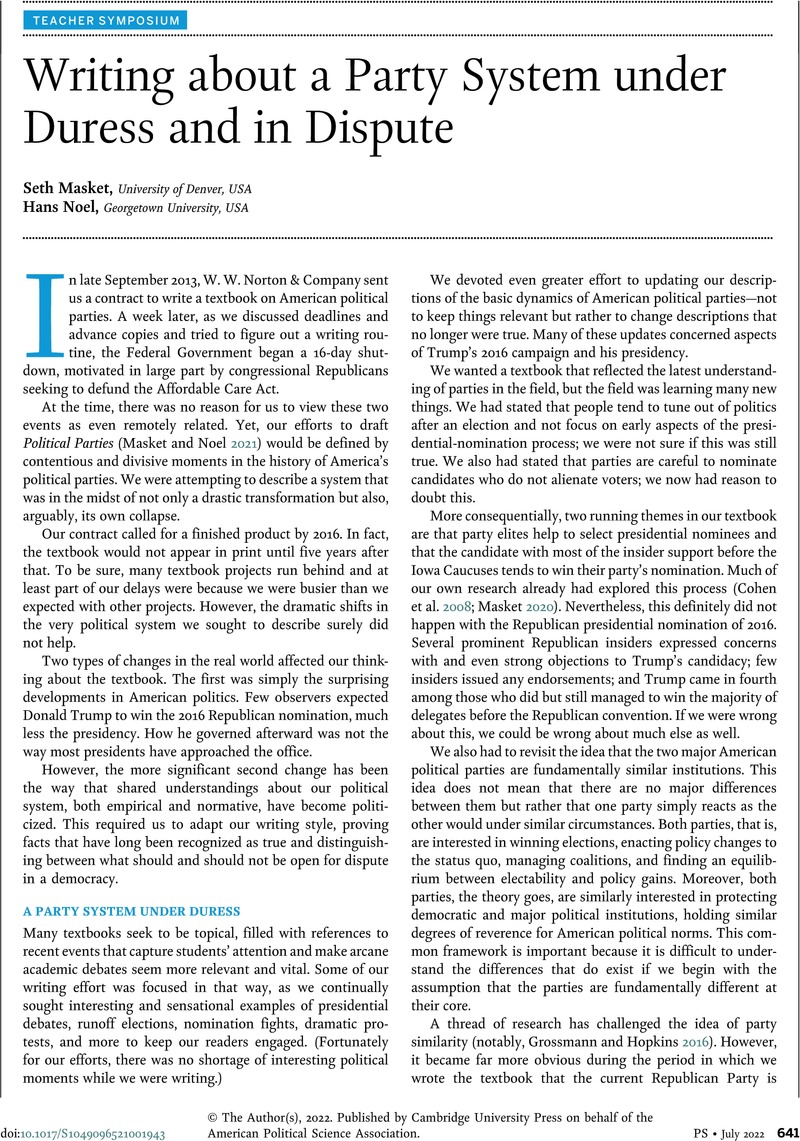No CrossRef data available.
Article contents
Writing about a Party System under Duress and in Dispute
Published online by Cambridge University Press: 30 March 2022
Abstract
An abstract is not available for this content so a preview has been provided. Please use the Get access link above for information on how to access this content.

- Type
- Lessons Learned from Political Science Textbook Authors
- Information
- Copyright
- © The Author(s), 2022. Published by Cambridge University Press on behalf of the American Political Science Association
References
REFERENCES
Carmines, Edward G., and Stimson, James A.. 1989. Issue Evolution: Race and the Transformation of American Politics. Princeton, NJ: Princeton University Press.CrossRefGoogle Scholar
Cohen, Marty, Karol, David, Noel, Hans, and Zaller, John. 2008. The Party Decides: Presidential Nominations Before and After Reform. Chicago: University of Chicago Press.CrossRefGoogle Scholar
Congressional Record
. 2021. 117th Congress (2021–2022), First Session. Vol. 167, No. 120, June 29. H3267.Google Scholar
D’Souza, Dinesh. 2018. Death of a Nation: Plantation Politics and the Making of the Democratic Party. New York: All Points Books.Google Scholar
Drutman, Lee. 2021. “Theft Perception: Examining the Views of Americans Who Believe the 2020 Election Was Stolen.” Democracy Fund Voter Study Group. www.voterstudygroup.org/publication/theft-perception.Google Scholar
Grossmann, Matt, and Hopkins, David A.. 2016. Asymmetric Politics: Ideological Republicans and Group Interest Democrats. New York: Oxford University Press.CrossRefGoogle Scholar
Klarman, Michael J. 2006. From Jim Crow to Civil Rights: The Supreme Court and the Struggle for Racial Equality. New York: Oxford University Press.Google Scholar
Levitt, Justin. 2007. “The Truth about Voter Fraud.” December 13. https://ssrn.com/abstract=1647224.CrossRefGoogle Scholar
Masket, Seth. 2020. Learning from Loss: The Democrats 2016–2020. New York: Cambridge University Press.CrossRefGoogle Scholar
Masket, Seth, and Noel, Hans. 2021. Political Parties. New York: W. W. Norton & Company.Google Scholar
Minnite, Lorraine C. 2011. The Myth of Voter Fraud. Ithaca, NY: Cornell University Press.Google Scholar
Mycoff, Jason D., Wagner, Michael W., and Wilson, David C.. 2009. “The Empirical Effects of Voter-ID Laws: Present or Absent?” PS: Political Science & Politics 42 (1): 121–26.Google Scholar
Noel, Hans. 2013. Political Ideologies and Political Parties in America. New York: Cambridge University Press.Google Scholar
Pennycook, Gordon, and Rand, David G.. 2021. “Examining False Beliefs about Voter Fraud in the Wake of the 2020 Presidential Election.” Harvard Kennedy School Misinformation Review, January 11.Google Scholar
Schickler, Eric. 2016. Racial Realignment: The Transformation of American Liberalism, 1932–1965. Princeton, NJ: Princeton University Press.Google Scholar
White, Ismail, and Laird, Chryl. 2020. Steadfast Democrats: How Social Forces Shape Black Political Behavior. Princeton, NJ: Princeton University Press.Google Scholar




